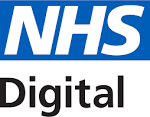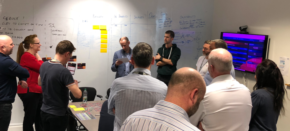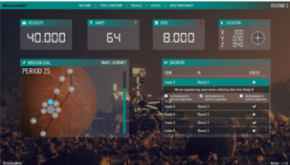MarsLander at NHS Digital
This article
In this article we describe the experience of a team of Service Managers from NHS Digital, who volunteered to participate in a test version of the MarsLander business simulation. This simulation is about a Mission to Mars. During this simulation a Mission Control Team has to support the mission objectives set by the Mission Director. In this dynamic, interactive workshop we encourage the team to experiment with Lean, Agile, DevOps, VeriSM™ and ITSM principles to create high performing service teams.
About NHS Digital and their Service Management journey
 NHS Digital is the national information and technology partner for the health and care system in the UK. It supplies information and data to the health service, provides vital technological infrastructure, and helps different parts of health and care work together. Historically NHS Digital was an outsourcing organization and Service Management was organized around ITIL processes to deliver end to end services with major technology companies. More recently the strategy shifted towards in-housing services, the use of open-source products and partnering with smaller organisations to open up the market. The increasing use of DevOps and the clear benefits of Agile drove Service Management to adapt its approach so that it is now organised into Agile, autonomous and multi-skilled cells who own specific services and work closely with DevOps teams and partners to make their services ever more valuable to customers and users.
NHS Digital is the national information and technology partner for the health and care system in the UK. It supplies information and data to the health service, provides vital technological infrastructure, and helps different parts of health and care work together. Historically NHS Digital was an outsourcing organization and Service Management was organized around ITIL processes to deliver end to end services with major technology companies. More recently the strategy shifted towards in-housing services, the use of open-source products and partnering with smaller organisations to open up the market. The increasing use of DevOps and the clear benefits of Agile drove Service Management to adapt its approach so that it is now organised into Agile, autonomous and multi-skilled cells who own specific services and work closely with DevOps teams and partners to make their services ever more valuable to customers and users.
We could never have scored the result we did in MarsLander, had we not already been through our own Agile Service Management journey
– Dave Lockett, Service Management Lead
About MarsLander®
The mission of your team is clear:
“Launch a rocket with MarsLander, bring it to Mars and collect valuable data for Universities and Research Centers”._ _
Your challenge is to support the Mission Center, helping ensure they are able to achieve all mission goals. The Mission Director is managing the Mission Center and leads a team consisting of Flight Operation, Navigation and Communication experts. These specialists manage the flight plan of the mission in accordance with mission goals and contractual agreements with the customers and suppliers.
The Mission Support Team consists of Support Engineers, Test Engineers and Change Management. They will fix all issues that occur during the mission. The Development Team develops and maintains applications, features and application fixes. Vendors are supporting the Mission Support Team with data communication services and data storage services.
The Service Manager will manage the Service Design, Service Delivery and Service Improvement.
The Simulation, what happened
Preparing the mission
The team started by analyzing the current backlog of work and making a first design of the services and processes within the team. They worked closely together with the business (Product Owner), Development and the IT Operations team. The team visualized the work using a Kanban and together with the Product Owner they set the priorities. The Development planned the first development activities.
At the end of this first round the team performed a retrospective, the following items were discussed:
- We need some facilitation in designing the correct flow and process.
- We had difficulties understanding the overall picture of how the issues and projects fit into the business goals and objectives. For this we will have to work more closely with the product owners.
- We were working in silos instead of as an end-to-end We all looked at our own piece of work and did not fully agree on end-to-end flow of work.
- Visualisation really helped, but we started with two separate tools. One for development and one for IT Operations.
How does this round reflect the NHS Digital journey?
- Under the organizational model that Service Management used to operate, it was often difficult to connect operational activities to the overall business objectives of the organization.
- The need to change does not make it obvious what changes need to be made, still less to make them. Different functions in NHS Digital responded differently to the updated strategy because they were still silo’d. This caused tension and takes time to work through.
Launch and heading to the comet Hardy IV
After a short Service Improvement cycle, we launched the rocket and started the mission. Now it became clear how the first version of our service worked out. It was still a big challenge how to set the right priority for all the work that needed to be done. The product owners were managing their business goals while the team was solving issues and finishing applications. It was a bit chaotic and the team members were searching for their positions in this team. The business achieved 60% of their financial targets. The score was a bit disappointing. We did not achieve all service objectives and business goals. But the team discovered a lot of interesting outcomes during this second round. We experienced some chaos caused by:
- Still some teams were working in silo’s
- We face some bottlenecks and constraints in our flow
- Lack of clear communication, no regular standups
- No shared goals and shared value
- Unclear priorities
- Too many disruptions due to lack of information needed to organize our own work
- We didn’t prepare for planned and unplanned flows
How does this round reflect the NHS Digital journey?
- Priorities are not easy to set or hold to once agreed and it is very easy to find that there is an overload of competing delivery demands, resource bottlenecks and a sense of ‘running to stand still’.
- Effective communication between people is so important to the learning process. Our Service Management cells now speak daily and usually in person with colleagues in DevOps, which enables people to focus around shared goals. The effort required to get this up and running and maintain it is significant, but quickly worthwhile.
Heading to Mars, making two orbits.
The third round started with a good preparation by the team. The service manager took the lead and designed a next ‘version’ of the service. Next version contains dedicated service teams for NAVCOM and Flight Operations. Flight Operations is now able to build small applications and release them. This will speed up the unplanned work flow. The team also introduced a better Kanban and standups.
The results were much better, faster solutions, more customer value and the sales went up. Also the flow was much clearer and the team enjoyed working like this.
Now I see direct results from my effort, since the product owner gives me direct feedback.
commented one of the Support Engineers in the Service Team Flight Operations.
As a product owner, I don’t need to ask for status updates all the time. I can simply check the Kanban a see if the team is working on the right issues or requests!.
The team was able to finish both orbits and in the meantime the development team used the free capacity to finish two crucial IT Projects so we could support HD Movie services to our customers.
We wouldn’t have been able to do this, had we did not trained the Service Teams to take over some small development tasks!
Still we discovered some service improvements for next round:
- We need to improve link between operations and development a bit more. Not by having the service manager running between both teams with work, but with standups with members of both teams.
- If work is not flowing, we need to have a standup to find out the reason and fix it immediately. We are now losing time searching for the right solutions.
- We need to share business goals, and expectations on the Kanban. This way the whole team knows the importance of some of the tickets without losing time.
How does this round reflect the NHS Digital journey?
- Our Service Management cells have been given the autonomy to develop their own local workflows that are visualized and managed on Kanban boards.
- The cells work hand in glove with their respective DevOps teams, attending multiple stand-ups focused on different services and projects, with an emphasis on self-organising to deliver their work.
- Becoming Agile has meant moving away from a belief that best-practice is a set of ‘known’ processes and outcomes towards a realization that good-practice is to focus on the next step forward towards a shared goal, which was always part of ITIL anyway.
Landing on Mars and making two trips.
The service manager took the lead in the last service improvement cycle. The team implemented the following services:
- Full end-to-end support of both teams, Flight Operations and NAVCOM
- Service Automation of AMPS monitoring
The MarsLander landed safely and on time. Well done team! And we were able to deliver the HD Movie services as agreed to the customer. This brought us an extra $ 500,000 revenue. Still in this round the team was not always aware of the mission. Sometimes the product owner had to explain that we were having the MarsLander on Mars, making picture and moves and collecting data. It seemed there was no clear picture of the mission within the team.
This last round went quite well. Issues were solved much faster than we had been able to in the previous round. The only challenge was to align the vendor with our end-to-end service flow. The vendor agreement did not align with the service agreement. As a result some issues took longer than agreed since the vendor took too much time to work it out.
Final conclusions
At the end we discussed how this simulation could help IT Service Teams to learn how to improve their services.
Here are the answers from the NHS Digital Service Managers:
- This simulation shows the effects of bringing business, development and operations closer together and acting as one team. It also gives participants a chance to experience how to do this in their own organization.
- This simulation shows in a very realistic way how good flow, good visualization and good team work can increase the performances of the teams.
- This simulation let participants practice how continual service improvement works. How incremental steps can bring you towards better services.
- This simulation shows how a journey could look like from a traditional service organization towards a more agile, lean and DevOps service team.
- This simulation shows how shared goals, shared values and a clear overall view on required outcomes can help the team to make their own decisions, to self-organize the team and to avoid unnecessary communication.
I thought that the simulation was a really good example of how making small iterative changes to a process can make a really big difference to the outcome
– Derek Sykes, Service Management Practitioner


